It had been a long time since I last went to Greece but I still have vivid memories of summer holidays spent there. Happy childhood days clambering freely over the Acropolis, wandering through the ruins of Knossos, sitting on the throne of King Minos, eating juicy chunks of watermelon on a hot, dusty road. I returned later as a young adult, fresh from secondary studies in classics, and hiked around the south coast of Crete. Then, whenever my travelling companions and I stopped for a meal and refreshments, we were invariably offered Ouzo, Retsina or Metaxa. Food was more often than not basic and rather greasy. Communication was carried out in a mix of ancient and modern Greek.

Pithoi (storage jars used for olive oil, wine, grain) in Knossos, Crete
How things have changed. During this summer’s vacation I did not have a single bad meal and not once was I recommended retsina. Restaurants served up a selection of succulent traditional and innovative dishes made from fresh local produce. There never was any problem in shops or when ordering food as everyone spoke English. As far as alcoholic beverages were concerned, Ouzo and Retsina have clearly lost the popularity contest to Greek wine.
The Greek wine industry has been going through a process of regeneration, rediscovering its wealth of indigenous grape varieties, and making use of new technology. There is plenty of innovation and experimentation at hand. As a result, Greece is today producing some fantastic wines that are not only high in quality but also totally individual. The country is reconnecting to its past. Wine is regaining its place in Greece’s cultural identity.
To find out more about Greece’s wines was partly what motivated me to choose the country as my holiday destination. It was, for me too, a reconnection to my past, a rekindling of neglected interests. This choice, however, proved particularly judicious: the rest of the family was thrilled. We spent two weeks enjoying wonderful weather, lovely beaches, good sightseeing, delicious food and wine, and fantastic hospitality.
Leaving a cool scandinavian summer behind us, we land at night in Athens, suddenly to be engulfed by heat and lively hubbub. A pleasing sensation of being somewhere foreign, where life operates in a slightly different or unexpected way, overcomes us. We amuse ourselves in deciphering signs and maps, and decide to take the bus from the airport to the centre of town. We sit on the bus, in total darkness, as the driver waits for more passengers. Finally, the engine switches on, along with some dim lighting, and we depart following a non-disclosed timetable.
Some three-quarters of an hour later we alight on the moon-bathed marble of Syntagma Square, and despite the late arrival of our plane we just make it to the hotel before the restaurant closes, and enjoy a Greek omelette and a bottle of Tselepos Moschofilero.

Tselepos Classic, PDO Mantinia 2011, Moschofilero
Tasting note: Tselepos Classic, PDO Mantinia 2011, 12% abv. This wine is made from Moschofilero. This is an aromatic grape variety that has a coloured skin. It produces wines that are characteristically fresh, lively, light, not too high in alcohol, with a floral and grapey flavour profile. The wines are usually drunk young. The wine we had here is from 2011. I am not sure whether the vintage was a conscious offering or an accidental one on the part of the restaurant. There was no vintage specified on the wine list… After initial surprise over the vintage, I was curious to see how the wine would have evolved. A deep warm straw colour, the wine displayed freshness and fragrances of delicate honey, raisins, dates, hazelnuts, thyme. On the palate, oxidative, sherry-like yet fresh aromas mingled with some sweetness and apple skin.

Parliament building and Syntagma Square, Athens
We wake up to a hot day and a view over the now quiet Syntagma (Constitution) Square and Parliament building. We have given ourselves one full day of sight-seeing in Athens before heading off to the islands. From our hotel we walk a little way up, past the elegant residence and gardens of the French Embassy to the Benaki Museum, which houses on the ground floor a permanent collection of mesmerising Greek art from the prehistoric times to the 3rd century A.D. After a pleasant lunch on the museum’s roof terrace, we set off through the narrow streets on an upward climb to the Acropolis. In spite of the important restoration work and scaffolding, the site remains as breathtaking as ever.
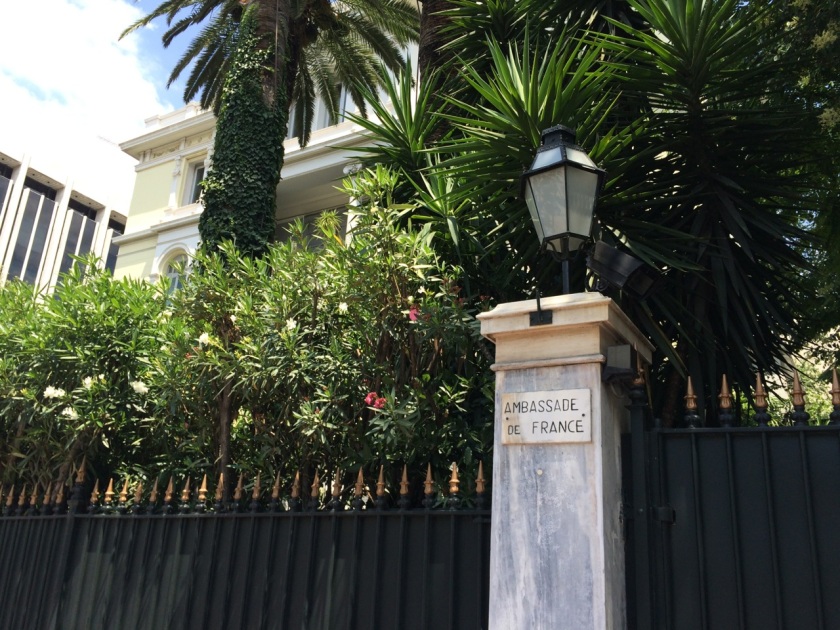
French Embassy, Leoforos Vassilissis Sofias, Athens

Red figure pottery with dancing maenad at the Benaki Museum, Athens
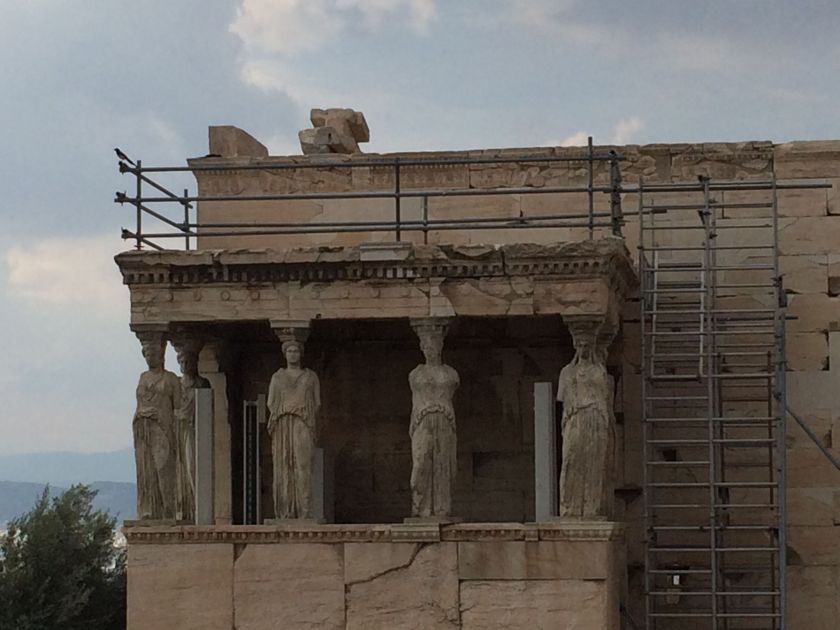
The Erechteion, Acropolis, Athens

Entrance to the Acropolis, Athens

The Parthenon, Acropolis, Athens
In the evening we traitorously exit our hotel only to walk straight into the one next door. It has an asset that our hotel doesn’t: a roof terrace with a restaurant. There we have supper facing the floodlit Acropolis. In the meantime demonstrators are starting to gather in the square below… If the food at the hotel – in keeping with the prevailing politics – seemed to be suffering from a slight identity crisis, unsure whether it should be outright Greek or suffused with a mix of European cuisines, the wine list offered an appealing selection of new Greek wines. We were tempted by a red Mavrotragano by Sigalas, but food and weather called for a refreshing thirst-quenching white Moschofilero by Seméli.

Seméli, Nassiakos, PDO Mantinia 2014, Moschofilero
Tasting note: Seméli, Nassiakos, PDO Mantinia 2014, 12% abv (Moschofilero). Pale gold in appearance. Fresh lemonade, Galia melon, honeysuckle, rose petal, Loukoum on the nose. Refreshing acidity and light in body, Gewürztraminer-like with aromas of Peach Melba, apricot and rose water on the palate.
The following morning a 40 minute dawn taxi ride takes us to Rafina harbour and we embark on a hydrofoil bound for the island of Paros. After quite a bumpy ride on a beautiful blue sea criss-crossed with white horses, we arrive at our destination. We weave our way from the quay to the main street through a whirlwind of lost holiday makers, suitcases, honking cars, donkey carts, and a throng of Greek taxi drivers and car rental agents come to greet the passengers off the ferry. One of them is Nick, who manages to spot us in the flurry. He hands us the keys to our rented car and away we drive. It’s only a short car journey away from the port in Parikia to our hotel in Kolymbithres.
Our four day stay on the island turns out to be way too short. Located in the Aegean Sea, Paros is one of the biggest of the Cycladic islands. These 56 islands are so named as they are spread out in a circle around the island of Delos, the birthplace of Apollo and Artemis, now a Unesco World Heritage site. Like many islands Paros has been invaded and inhabited by many different civilisations and has a rich past.
There is more to see on the island than one might expect. Today the main source of wealth of the island is tourism. In the Antiquity it was marble and it brought fame to the island. Parian marble was sought after for its beautiful fine grain, its flawlessness and white translucency. It was used by many Greek sculptors during the Classical period and it is believed to be the stone out of which the Venus de Milo has been carved. The quarries are no longer exploited but they can be visited and are situated in the village of Marathi, east of Parikia. Ten minutes away by car from Marathi, right in the centre of the island, up in mountainous terrain, lies the village of Lefkes. Once the capital of the island, it is worth a detour for its traditional houses, Byzantine church, and Venetian architecture. If one is interested in Byzantine art, the lively capital, Parikia, has a small museum devoted to it.
Kolymbithres, where we chose to stay, is located in a bay in the north of the island. Our hotel is built in the traditional style: little separate houses with white-washed exteriors, small windows with shutters to keep the strong sunlight out and a patio to enjoy a drink in the balm of the evening heat.

Hotel Kouros, Kolymbithres, Paros

The pool at Hotel Kouros, Kolymbithres, Paros
The area is renowned for its beautiful beaches and coves. White sand or eroded rocks, clear turquoise, aquamarine shallow waters that stretch far out and provide a foothold for unsteady swimmers. Bringing perfection to the setting are the constant breezes that keep the skies blue and temper the heat.

Port in Naoussa, Paros

Fishermen repairing nets in Naoussa, Paros

Naoussa harbour, Paros. Not today, thank you.
Further along the bay, opposite Kolymbithres lies the small fishing town of Naoussa. Charming, narrow, windy pedestrian streets paved with slabs of grey stone, small white-washed houses with brightly painted doors and window frames. In the heat of the day people amble through the town, gravitating around the central square, where they browse in the paper shop and stop for coffee. In the evenings the whole town is alive with tourists who stroll along the quayside, walk up and down the maze of streets, exploring the small boutiques, peering at menus and in people’s plates in search of the right restaurant. There are plenty of restaurants in Naoussa. The really good ones though get booked up pretty swiftly and need to be reserved a number of days in advance.

Soso restaurant, Naoussa, Paros
The two best ones in Naoussa are undoubtedly Soso and Yemeni. Both are family run restaurants that serve Greek food using fresh seasonal and local produce. On our first day on Paros, we got hopelessly lost looking for Soso. We walked through quiet unattractive back street and ended up in the wrong restaurant, which was devoid of diners and where the owner begrudgingly pointed us in the right direction. Finally, we found our table, tucked away in an alley, up against a typical traditional white cycladic house with deep pink bougainvillea tumbling from above. Luckily our reservation had been kept, the place was buzzing with diners chatting and munching happily away.
Food, of course, is the perfect prompt for trying new wine. Both Soso and Yemeni have a good selection of reasonably priced Greek wine.

Santo Wines, Santorini PDO, Nykteri 2014 at Soso restaurant, Naoussa, Paros
At Soso we tried a white blend, Nykteri, PDO Santorini, 2014, 14% abv, produced by Santo Wines, the cooperative on the island of Santorini. The main grape in the blend is Santorini’s indigenous, star variety: Assyrtiko. The wine is refreshing, crisp and citrusy. The power and incisiveness that Assyrtiko can display is here toned down by the other two grape varieties, Athiri and Aïdani, that add some softness to the blend.

Moraitis, PDO Paros, 2013, Monemvasia, at Yemeni restaurant in Naoussa, Paros
At Yemeni the food is more Greek traditional and includes deliciously prepared dishes such as feta parcels wrapped in filo pastry, smoked aubergine salad and kebabs. The wine list comes on a small, slightly crumpled, lined notepad handwritten in blue pen. Wanting to taste both a white and a red, we asked the owner Nikos for recommendations of wine-by-the-glass.
The white wine, excitingly, is from Paros: Moraitis, PDO Paros 2013, 13% abv. Smoky, lemon and lime cordial, almond paste, Bassett’s blue liquorice, citrus with a hint of bitter lemon peel and soft acidity. The richness of the wine was achieved through a six months on the lees barrel maturation. The grape variety, which takes its name from a port in Laconia in the Peloponnese where it probably originated, is Monemvasia. It grows in the Cycladic and Aegean islands but mainly on Paros where it is one of signature grapes of the Moraiti Winery. As it turns out, the Moraiti Winery is located in Naoussa. It is all set up for visitors with a small museum, large tasting room and great hospitality (www.moraitiswines.gr). Find out more on Moraiti winery in a forthcoming blog post.
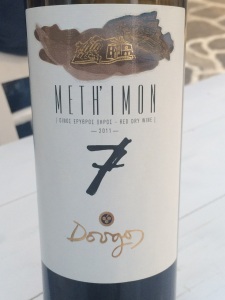
Dougos, Meth’Imon 7, 2011, Greece
The red wine was a big gun, so named Meth’Imon “7” as seven grape varieties, both French and indigenous can go into its making: Limniona, Syrah, Grenache, Cabernet Franc, Merlot, Cabernet Sauvignon, and Batiki. Deep purple in colour, succulent, complex, supple, sweet yet fresh, spicy dark fruit, plums and vanilla, this award-winning wine comes from the Dougos Winery in central Greece. The vineyards are located on the slopes of Mount Olympus.

Ktima Biblia Chora, Ovilos 2014, PGI Pangeon, Greece
Ktima Biblia Chora’s Ovilos 2014, (13.5% abv) was another super wine tasted in Naoussa. Not only beautiful in appearance with its colour of intense pale gold, but also expressive and full-bodied on the palate. The wine is barrel fermented and is a blend of Assyrtiko and Semillon. A combination that works incredibly well and that produces notes of honey, apricot, white peach, lemon and lime with a backbone of zesty acidity. The wine is from the Biblia Chora estate in Macedonia, northern Greece, in the area of the Pangeon mountain. Away from its place of origin, it is not uncommon for Assyrtiko to be blended with international grape varieties. Indeed the Pangeon Protected Geographical Indication (PGI) includes many international grape varieties such as Chardonnay, Sauvignon Blanc, Semillon, Cabernet Sauvignon, Grenache, to name a few, along with Greek ones.
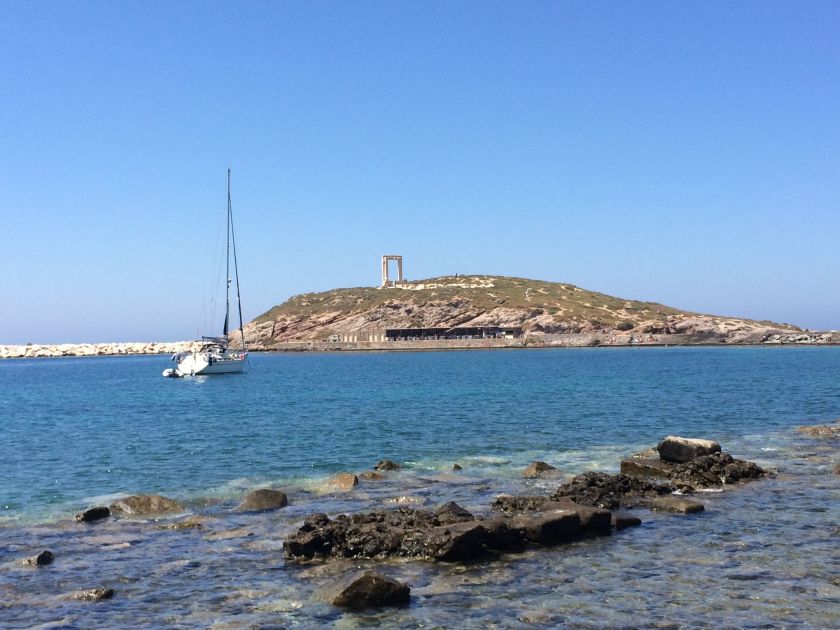
The Portara, doorway to the unfinished temple of Apollo at Naxos, Greece

Naxos harbour, Greece
Before returning to Athens, we spend a long week-end in Naxos. The biggest island of the Cyclades, Naxos makes a strong visual impact with its striking landmark, the doorway to the temple of Apollo, which juts out and greets you as you sail into port. It is also the island on which Ariadne, daughter of King Minos of Crete, was abandoned by Theseus after she helped him kill the Minotaur. According to some versions of the myth, Ariadne then wed Dionysos, god of wine. Despite its mythogical connections, Naxos does not have a notable wine production. It is, however, renowned for its vegetables, potatoes in particular, meat and dairy produce. It is also a favourite spot for windsurfers and has especially strong winds, which we witnessed first hand during our boat crossing, notably between the coasts of Paros and Naxos. There is here much to visit on Naxos and for that a car is necessary.
We opted for total relaxation and chose a boutique hotel with a pool and a restaurant -recommended, incidentally, by the travel section of The Telegraph newspaper – and we stayed put. We were not disappointed. Kavos Hotel at Agios Prokopios is a gem of a hotel. Tastefully decorated villas, a welcoming staff, delicious food (fantastic breakfasts), a good wine list and lovely pool.

Individual villas at Kavos Hotel, Naxos, Greece

Poolside restaurant at Kavos Hotel on Naxos, Greece

Moraitis Sillogi 2014, PGI Cyclades
Moraitis Sillogi is one of the wines that we bought at the winery in Paros and that we drank at sunset on our terrace at Kavos hotel before going for supper. The hotel, however, also happens to have it on its wine list and it is no surprise.
Moraitis Sillogi 2014, PGI Cyclades is a crowd pleaser. Pale lemon green in colour, floral notes, with sweet ripe lemons, grapefruit, green apple, a smooth body, refreshing acidity and a dry backbone. The wine is made from organically grown grapes and is an Assyrtiko-Malagousia blend.

Pavlidis Thema 2013, PGI Drama
Ktima Pavlidis Thema White 2013, PGI Drama (13% abv) is another Assyrtiko blend. It shares similarities with the Ktima Biblia Chora Ovilos. It is from Macedonia in northern Greece and is blended with an international grape variety, in this case not Semillon but Sauvignon Blanc.
The aromas and fragrances of this wine are all vegetal and citrusy. Fresh lemon, lime flavoured boiled sweets, asparagus and green bell pepper are interwoven in this full-bodied blend with a racy acidity and zesty finish.
Air connections to Stockholm not being that convenient we take a hydrofoil back to Athens. The Referendum vote has closed the day before and the city is electric. The place is crawling with journalists of all nationalities. In our hotel every room overlooking Syntagma Square is occupied, primarily by the press who have set up their lights and cameras on the balcony for news broadcast. You have to watch your feet in the lobby for fear of stumbling over tripods or cameras. We try a restaurant around the corner and here too, cameras and tripods are lying casually amongst the tables. At 10h30 pm all the tables are taken and we have to wait.

O Tzitzikas ki o Mermigkas, Athens, Greece
We toast our last night with a Santorini Assyrtiko from Sigalas to accompany the modern Greek (and occasionally slightly wacky) cuisine of O Tzitzikas & Mermigas. On our table a vegetable mille-feuille with Mastelo cheese from Chios, grilled vegetables and a basil dressing; meatballs with fresh mint and fried potatoes; “Mastihato” chicken fillet in a kadaifi pastry nest with Chios mastic sauce and bacon. An echo to the bounteousness of the Cyclades, the Sigalas Santorini PDO 2014 is a pure Assyrtiko: pale lemon colour in appearance, a touch of limes, citrus, yellow apples, wet stones on the nose; on the palate pure minerality, high acidity, saltiness, a little oiliness and some lactic undertones.

Sigalas Santorini PDO, 2014 – Assyrtiko
How to get there
Aegean Airlines
Scandinavian Airlines
Paleologos ferries (www.paleologos.gr)
Akropolis car rental, Parikia, Paros (www.acropolisparos.com)
Where to stay
NJV Athens Plaza Hotel (www.njvathensplaza.gr)
King George Athens (www.kinggeorgeathens.com)
Hotel Kouros, Naoussa, Paros (www.hotelkouros.gr)
Kavos Hotel, Naxos (www.kavos-naxos.com)
Where to eat
King George Athens
Tzitzikas & Mermigas, Athens (www.tzitzikasmermigas.gr)
Soso, Naoussa, Paros
Yemeni, Naoussa, Paros
Where to visit
Benaki Museum
Goulandris Museum of Cycladic Art
The Acropolis
Moraitis winery, Naoussa, Paros (www.moraitiswines.gr)
Where to source Greek wine
http://www.wine-searcher.com

Post Referendum, Syntagma Square, Athens
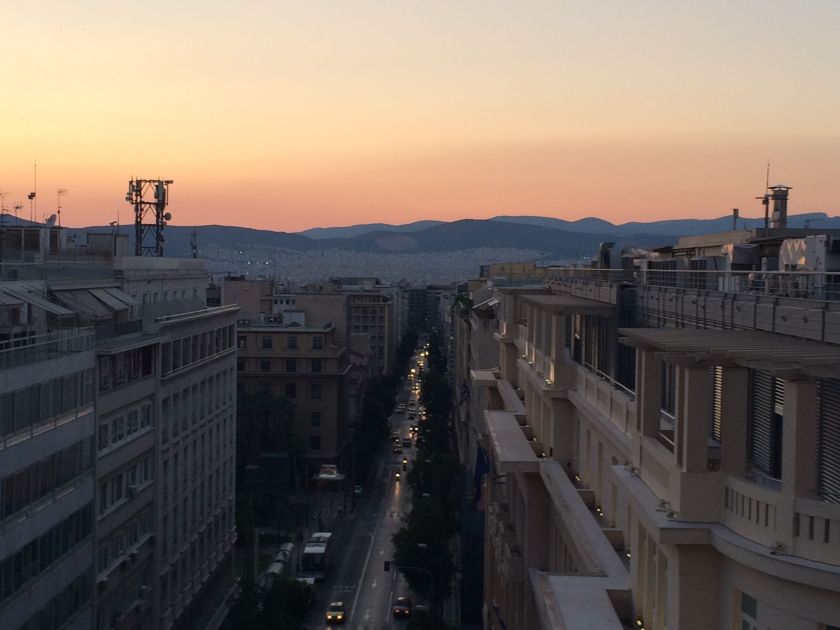
Athens at night
All images by Sarah Jefford

Dear Sarah,
Superbly well done. You capture the essence of your visit to perfection.
Professor Dr C.W. Jefford
Institute of Chemical Design
LikeLike
A most interesting article, well written and informative. I have taken a copy to follow in her great advice on food, wine and hotels in the area.
LikeLike
Hi Sarah,
Excellent article.
Bob
LikeLike
Gosh, thanks Bob! That is a blast from the past! Nice to get a word from you. Hope all’s well.
Sarah
LikeLike
Hi Sarah,
Got long message from Charles.Thanks.I have longstanding connection with Sweden and its wines.
In 1960 Swedish wine taste was mainly driven by the % EtOH.I remember Sat afternoons
standing on long lines outside of unmarked Spirit shops and getting my extra weak wine in plain brown paper bags.Very guilt provoking excercise.My temporary home was in Overkalix where
wine was not consumed in favor home brew.I look forward to reading your Nordic wine blog to learn of the progress made in the Swedish Vine Culture.
Bob
LikeLike